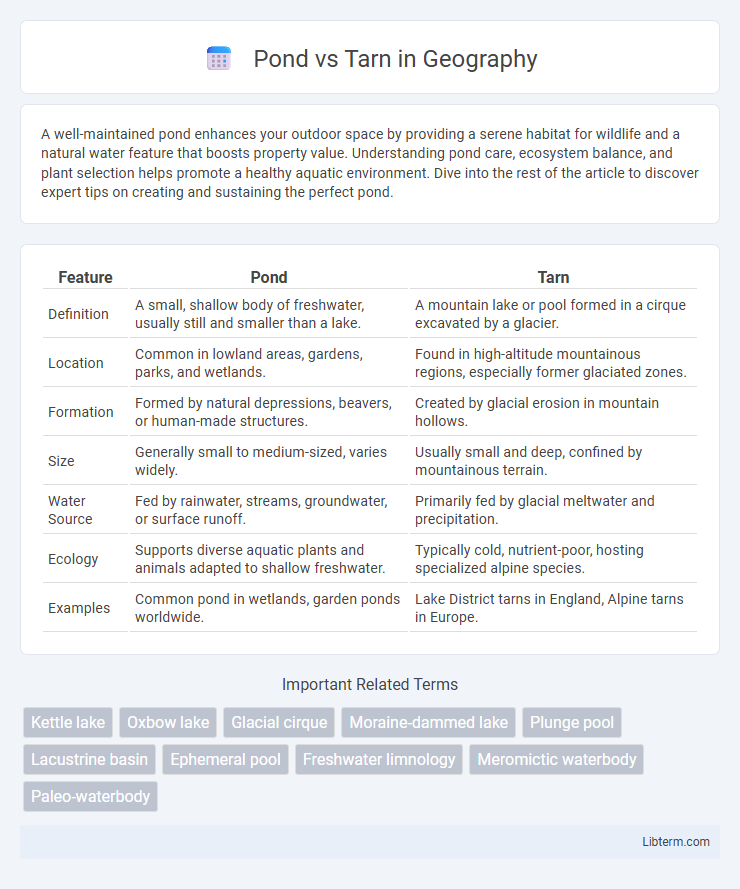A well-maintained pond enhances your outdoor space by providing a serene habitat for wildlife and a natural water feature that boosts property value. Understanding pond care, ecosystem balance, and plant selection helps promote a healthy aquatic environment. Dive into the rest of the article to discover expert tips on creating and sustaining the perfect pond.
Table of Comparison
| Feature | Pond | Tarn |
|---|---|---|
| Definition | A small, shallow body of freshwater, usually still and smaller than a lake. | A mountain lake or pool formed in a cirque excavated by a glacier. |
| Location | Common in lowland areas, gardens, parks, and wetlands. | Found in high-altitude mountainous regions, especially former glaciated zones. |
| Formation | Formed by natural depressions, beavers, or human-made structures. | Created by glacial erosion in mountain hollows. |
| Size | Generally small to medium-sized, varies widely. | Usually small and deep, confined by mountainous terrain. |
| Water Source | Fed by rainwater, streams, groundwater, or surface runoff. | Primarily fed by glacial meltwater and precipitation. |
| Ecology | Supports diverse aquatic plants and animals adapted to shallow freshwater. | Typically cold, nutrient-poor, hosting specialized alpine species. |
| Examples | Common pond in wetlands, garden ponds worldwide. | Lake District tarns in England, Alpine tarns in Europe. |
Understanding the Difference: Pond vs Tarn
A pond is a small, shallow body of freshwater, often man-made or naturally formed, characterized by still water and abundant plant life. A tarn is a specific type of mountain lake formed in a cirque carved by glacial activity, usually found at high elevations and distinguished by its clear, cold water. Understanding the difference involves recognizing that ponds are generally lowland and biologically rich, while tarns are alpine features shaped by glaciation with distinct geological origins.
Defining Ponds: Characteristics and Features
Ponds are small, shallow bodies of still water, typically less than 2 meters deep, with abundant sunlight reaching the bottom, supporting diverse aquatic vegetation and wildlife. Unlike tarns, which are glacially-formed mountain lakes characterized by clear, cold water and rocky surroundings, ponds often form in lowland areas and have murkier water due to organic matter accumulation. Their ecosystems feature a mix of emergent, submerged, and floating plants, providing crucial habitats for amphibians, insects, and freshwater fish.
What is a Tarn? Geological Origins Explained
A tarn is a small mountain lake formed in a cirque excavated by a glacier, characterized by its clear, cold water and steep surrounding rock walls. Geological origins trace back to glacial erosion during the last Ice Age, where ice scoured depressions in alpine regions that later filled with meltwater. Unlike ponds, which can form from various processes such as sedimentation or beaver activity, tarns specifically result from glacial carving in high-altitude environments.
Formation Processes: Pond vs Tarn
Ponds form through various processes such as glacial activity, tectonic movements, or human excavation, typically resulting in shallow, small water bodies with still water. Tarns specifically originate in mountainous regions within glacial cirques, created by the erosion and retreat of glaciers, forming deep, clear, and often cold alpine lakes. Both bodies hold ecological significance but differ fundamentally in their glacial formation and geographical context.
Size and Depth Comparison
A pond is generally smaller and shallower than a tarn, with ponds often measuring less than two hectares in surface area and rarely exceeding a depth of six meters. Tarns are glacial in origin and typically found at higher elevations, featuring deeper basins that can exceed 10 meters in depth despite covering smaller surface areas. The depth variation significantly influences the ecological characteristics and thermal stratification between ponds and tarns.
Ecological Significance of Ponds and Tarns
Ponds serve as critical habitats for diverse aquatic plants, amphibians, insects, and microorganisms, supporting biodiversity and nutrient cycling within ecosystems. Tarns, formed in glacial hollows, provide unique cold-water environments that sustain specialized species adapted to low temperatures and reduced nutrient levels. Both water bodies contribute to ecological balance by regulating microclimates, promoting groundwater recharge, and supporting food webs in their respective landscapes.
Typical Locations: Where to Find Ponds and Tarns
Ponds commonly form in low-lying areas such as gardens, parks, and wetlands, often created by natural depressions or human intervention. Tarns are typically found in mountainous or glacial regions, occupying small cirques or rock basins carved by ancient glaciers. The distinct locations highlight ponds' prevalence in varied, accessible environments versus tarns' specialized, high-altitude settings.
Flora and Fauna Diversity
Tarns typically exhibit lower biodiversity due to their high-altitude, oligotrophic conditions, supporting specialized alpine flora such as mosses and lichens and limited fauna like cold-adapted invertebrates. Ponds, found at lower elevations with more nutrient-rich waters, support a wider array of aquatic plants including emergent species like cattails, and diverse fauna such as amphibians, insects, and fish. The richer vegetation in ponds provides habitat complexity that fosters greater species richness compared to the more sparse ecosystems of tarns.
Human Interaction and Uses
Ponds often serve as recreational and agricultural resources, supporting activities like fishing, irrigation, and wildlife observation, reflecting significant human interaction and management. Tarns, typically found in mountainous regions, are less accessible and primarily valued for their ecological importance and scenic beauty rather than direct human use. Human influence on ponds includes artificial creation and maintenance, while tarns generally remain natural features with minimal alteration.
Key Takeaways: Pond vs Tarn Summary
A pond is a small, shallow body of water usually formed naturally or artificially, supporting diverse aquatic plants and animals, while a tarn is a mountain lake formed in a glacially-carved cirque, typically found at higher elevations with clearer, colder water. Ponds tend to have richer sediment and warmer temperatures, fostering more vegetation, whereas tarns are deeper, less biologically diverse, and often surrounded by rocky terrain. Understanding these distinctions helps ecologists and geographers differentiate ecosystems based on origin, location, and biodiversity.
Pond Infographic

 libterm.com
libterm.com